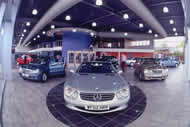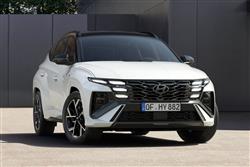Presenter Jonathan Crouch
Click here to view Jonathan's biography.
Used Car Guides
Group Tests
Bespoke Dealer Videos
Home | New Car Road Tests | 4x4s | Hyundai Tucson Plug-in Hybrid
Road Test Video
New Car Road Test | Hyundai Tucson Plug-in Hybrid
PLUG & PAY
Hyundai's improved Tucson Plug-in Hybrid is hardly inexpensive, but you get a lot in return. Jonathan Crouch takes a look.
Ten Second Review
Hyundai's mid-sized SUV, the Tucson, looks more sophisticated in this improved fourth generation form. In this Plug-in Hybrid form, it can go up to 38 miles on a charge and, unlike some rivals, includes the option of four wheel drive, so you'll be well set in the Winter. If you're looking for a PHEV crossover of this kind, it's a car you can't afford to ignore.
Background
Hyundai has pushed its Tucson mid-sized SUV further up-market in this model's fourth generation, especially with the car in this improved form. Which means the need for plenty of technology; like the Plug-in Hybrid powertrain used in the flagship model we're going to look at here.
It completes what Hyundai still claims is the widest range of powertrains available from any model in this class. Well, there's no full-EV variant - the brand doesn't need to provide that as it has its latest IONIQ 5 offering a full-battery option in the Crossover segment. But you can certainly have just about everything else in a Tucson; anything else petrol-powered anyway. Hyundai doesn't do diesels in SUVs any more.
What you can have with mainstream Tucsons is a choice of 1.6 T-GDi petrol variants; a conventional un-electrified option; or a version with MHEV mild hybrid tech; or one with full-Hybrid HEV tech that can run independently on full-battery power, though only for short periods. This PHEV Plug-in version though, can be battery-sustained for far longer. Let's take a look.
Driving Experience
All Tucsons continue to be powered by a 1.6-litre T-GDi petrol engine wedded to some form of electrification - and this one's no exception. In this case, the turbocharged combustion unit is mated to a 91PS electric motor powered by a 13.8kWh battery which, when fully charged, can take you up to 31 miles before the engine cuts in. Drive is sent to all four wheels - unlike some obvious rivals, the Ford Kuga PHEV and Hybrid versions of the Vauxhall Grandland and the Citroen C5 Aircross for instance, which are 2WD-only. And it's all marshalled via an 8-speed auto gearbox with proper cogs, unlike the belt-driven CVT transmission you have to have in rival Toyota RAV4 Plug-in and Suzuki Across models in this class.
Typical customers are unlikely to ever want to take this car off road, but should the need for extra 'off piste' traction ever arise, there's a 'Terrain Mode' system which provides settings that vary power delivery to each axle according to the surface you're travelling over. On tarmac, a combined 265PS output gives sprightly performance, despite this PHEV's prodigious 1.9-tonne kerb weight; 62mph from rest takes 8.6s en route to 120mph and the stab of electric torque you get when you put your foot down makes it feel faster, particularly when you activate the provided 'Sport' setting.
Design and Build
Aside from altered badging and the addition of an extra charging flap, there aren't really any significant visual differences to mark this Plug-in Hybrid Tucson variant apart from its less electrified showroom stablemates. Still, in all its forms, the fourth generation 'NX4'-series version of this design has enough about it to set High Street tongues wagging. The updates to this model are uber-subtle. Look closely and you might notice the thinner, more angluar lines of the radiator grille and the revised front bumper.
As before, the front end styling is dominated by the brand's 'Parametric Jewel' daytime running lights borrowed from the company's previous Vision T concept, which represented what Hyundai has called 'a design revolution'. The 'jewel-like' running lights are integrated into the sides of the 3D grille and can't be distinguished from it when switched off. As before, this MK4 model is oner of the larger mid-sized SUV segment models, at 4.5-metres long. And sits on big wheels of between 17 to 19-inches in size.
Inside up-front, the changes to this facelifted model are much more noticeable. Borrowing from the cabin design theme seen in the company's latest EVs, the twin screens are now 12.3-inches in size (up from 10.25-inches before). One is for the instrument cluster; the other is for the centre stack and incorporates Hyundai's latest Bluelink telematics. The redesigned dashboard has a new horizontal crash pad design supposed to create a sense of openness. Physical heating and ventilation controls and a redesigned centre console with buttons for regularly used functions feature on the new centre console, whilst the automatic and hybrid powertrains feature a wireless charging pad housed in the centre armrest.
As before, there's quite a spacious back seat - a 10mm longer wheelbase increase for the original version of this MK4 model improved that and added 26mm more legroom. And the boot offers up to 558-litres of space in PHEV models (down from 620-litres in the ordinary variants).
Market and Model
The Plug-in Hybrid version of this Tucson comes in all the usual Tucson trim options - 'Advance', 'Premium', 'N Line', 'N Line S' and 'Ultimate'. That means prices starting at just under £40,000 for 'Advance' trim; you'll pay just under £42,000 for either the 'Premium'-spec model or the alternative sportier-looking 'N Line' variant. That's a figure which represents a premium of just over £3,500 over the alternative full-Hybrid HEV variant - and around £7,000 over the MHEV mild hybrid model. So you've really got to want plug-in tech, especially if you're to stretch to one of the plusher trim levels - which can see prices rise to as much as £46,000.
Still, across the range, you do at least get plenty of kit for your outlay. The twin 12.3-inch interior screens are one example of that, the central infotainment monitor not only including 'Android Auto' and 'Apple CarPlay' connectivity but also Google and Apple calendar integration, along with selectable user profiles. There's also a 'last mile navigation' feature, meaning that if the driver won't be able to find a place to park actually precisely at his or her intended destination, further directions can be sent to their smartphone so that the final part of the journey can be finished on foot. Live parking and traffic information is also included, thanks to up-to-the-minute Hyundai Bluelink telematics.
And of course there are up-to-the-minute driver assistance safety features, including the company's latest 'Highway Drive Assist' semi-autonomous capability. This can brake and accelerate the Tucson to keep it a pre-set distance from other motorists, using a 'Lane Follow Assist' system to keep the car in lane on major roads. There's even a 'Remote Smart Parking Assist' feature, allowing the car to be summoned from a parking spot via a button on the key.
Cost of Ownership
If you're comparing the Plug-in Hybrid Tucson with its HEV self-charging Hybrid showroom stablemate, you'll find that this Plug-in variant's provision of a larger 91PS electric motor powered by a considerably larger 13.8kWh battery makes all the difference. It facilitates the usual PHEV three-figure combined economy reading - think in terms of around 180mpg. And an enviro-conscious CO2 figure of 31g/km. Which in turn makes possible a super-low Benefit-in-Kind taxation rating of just 10%; with the HEV, it'd be around 29%, depending on trim. The WLTP combined economy figure is 201.8mpg.
A Tucson Plug-in Hybrid owner qualifies for a low VED tax band B, so there'll also be no VED road tax to pay in year one (the self-charging HEV models are in VED bands H or I). Servicing is every 10,000 miles. And insurance is rated at group 21E. Let's finish with charging time figures. This model has a 7.2kW on board charger and can be charged from a 3-pin ICCB supply in 6 hours and 30 minutes (empty to 95%). Use the kind of 7kW wallbox you'd obviously install at home if you were to choose a Plug-in Hybrid and that time drops to 1 hour and 42 minutes. When fully replenished, the battery can take you up to 38 miles on a single charge.
A strong buying incentive, as usual with Hyundai, is the five year unlimited mileage warranty that comes as standard. It's backed up by breakdown cover that last the same length of time and free annual vehicle health checks over this duration. True, rival brand Kia claims to better this package by offering a similar seven year deal, but there, you're limited to 100,000 miles.
Summary
As usual, Hyundai has taken established technology and made it available slightly more affordably. What's different with this Tucson Plug-in Hybrid though, is that the packaging makes the end confection genuinely desirable. There's real pavement presence here, especially with this improved model, so the neighbours might take a second glance over the fence. No previous generation Tucson was ever like this. No previous generation Tucson ever delivered a three-figure fuel return or a sub-35g/km CO2 reading either. In short, there are plenty of ways that this top version of the fourth generation model will surprise you.
Unfortunately, pin-sharp involving driving dynamics don't number amongst these. There's nothing particularly rewarding about driving this car, but then you can't really say that about any of its direct rivals either. Also common with the competition is the kind of premium pricing that will have a potential Tucson Plug-in Hybrid customer wondering whether he or she might not be equally happy with the more affordable HEV Hybrid or MHEV Mild Hybrid models further down the range that can't be plugged in. If you want cutting-edge technology to match this fourth generation Tucson's cutting-edge looks though, this PHEV variant has, as Hyundai puts it, 'the power to surprise'.
Related Road Tests
Browse the other models
Currently viewing New Car Road Tests, switch to Used Car Road Tests
Select a model to browse through the videos.





.jpg)
.jpg)
.jpg)
.jpg)
.jpg)
